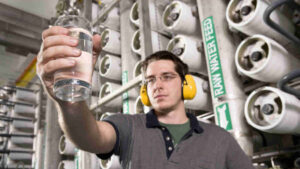When it rains it pours: water treatment stocks surge 260 per cent

Pic: Yuichiro Chino / Moment via Getty Images
The world’s demand for clean water keeps increasing, but supply is not keeping up.
Water use has risen 1 per cent per year since the 1980s and more than 2 billion people live in countries with high water stress.
China, for example, has eight provinces with an ‘absolute scarcity’ of water — meaning less than 500 cubic metres per person. Several more provinces are only just above this threshold.
In India, an estimated 70 per cent of its water supply is contaminated.
Even the most developed countries aren’t immune from water crises. The US city of Flint has suffered water contamination since 2014 from lead pipes emitting oxide into the water.
But this may just be the tip of the iceberg. A study by the Environmental Working Group earlier this year found up to 43 US states had locations with contaminated water.
This is a big problem — but highly lucrative if you have a solution.
The stocks involved
There are more than a dozen ASX small caps in the water industry but only five ASX small caps are involved in water treatment. These have made an average gain of 260 per cent in the last 12 months.
| Code | Name | Price (I) | 1Y Tot Ret | 6M Tot Ret | Market Cap |
|---|---|---|---|---|---|
| PO3 | PURIFLOH LTD | 4.51 | 718 | -1 | $141.2M |
| PET | PHOSLOCK ENVIRONMENTAL TECHNOLOGIES | 1.215 | 192 | 226 | $703.2M |
| FLC | FLUENCE CORP LTD | 0.525 | 31 | -4 | $282.2M |
| SDV | SCIDEV LTD | 0.405 | 352 | 600 | $48.2M |
| DEM | DE.MEM LTD | 0.21 | 6 | 37 | $33.3M |
Two of these are targeting the Chinese market which is particularly lucrative because of its large population and state support for water treatment. China’s most recent five year plan aimed to spend 559 billion yuan ($116 billion) on water treatment — 0.75 per cent of GDP.
One is Phoslock Environmental Technologies (ASX:PET) which has nearly tripled in a year. The company uses a phosphate-based treatment to clean large bodies of water.
Phoslock’s boss Rob Schuitema spoke with Stockhead earlier this year and told us he aimed to become a billion dollar company.
“There are thousands of lakes that need Phoslock and we only need 10 of them to be a billion dollar company… and this current project is putting us well on the way to that”, he said. It is on the way — but not quite there yet with a market cap just under $700 million.
By the current project he was referring to a $1m deal for its products, won from the Chinese government. This came from a trial in the Xingyun Lake where it cut phosphorus by 75 per cent.
Since then it has continued to win projects. Arguably its most notable was announced last week where it would apply Phoslock to China’s second biggest downtown lake, Wuhan City.
Another company targeting China, among others, is Fluence (ASX:FLC) which produces biofilms. Essentially these are micro-organisms which break down undesirable compounds in the water.
But it also builds desalination plants, including one in Brazil that when complete will be the nation’s largest.
Miners & brewers need water too
SciDev (ASX: SDV) serves the industrial clients (particularly miners), not only with water treatment but chemicals.
Its clients include large cap miner Iluka Resources (ASX: ILU) for its Jacinth-Ambrosia project — the world’s largest zircon mine; as well as the PNG’s Ramu Nickel Mine.
The latter is being worked on with water-soluble polymer manufacturer Nuoer Group.
Singaporean-headquartered DeMem (ASX: DEM) is another provider of filtering technology. It applies at the end of the treatment where the water is passed through a membrane and only water molecules pass through.
Its clients are predominantly miners, one of them being Rio Tinto for its Amrun bauxite mine in far north Queensland. But it is also aiming to apply it to food products — to ‘de water’ them.
The standout
The best performer, up over 700 per cent in 12 months, is Purifloh (ASX:PO3). Its trade is purifying technology (Free Radical Generation) which is applicable to water but also to air as well as surfaces and equipment (such as surgical tools).
Its rise was triggered last November when American billionaire Bill Parfet bought in at 5 times its current price. But it has continued to rise since then.
Beer & Co analyst Pieter Bruinstroop said earlier this year that by 2033 it could hold 16.4 per cent of the North American water treatment market and 28.4 per cent of Australia’s.
Yet initially it will target the recreational market, meaning residential and commercial pools. This may not be as compelling story as quenching the thirsty but it works like chlorine but without the skin irritation, underwater visibility issues and infrastructure damage that comes with it.
UNLOCK INSIGHTS
Discover the untold stories of emerging ASX stocks.
Daily news and expert analysis, it's free to subscribe.
By proceeding, you confirm you understand that we handle personal information in accordance with our Privacy Policy.








